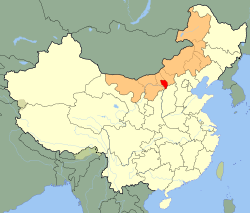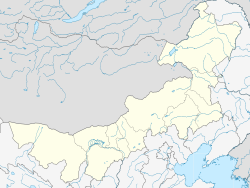Tenduc
|
Hohhot 呼和浩特市 • ᠬᠥᠬᠡᠬᠣᠲᠠ |
|
|---|---|
| Prefecture-level city | |

Clockwise from top: monument of Genghis Khan, Governor of Suiyuan General, Temple of the Five Pagodas, Zhaojun Tomb.
|
|
 Hohhot (red) in Inner Mongolia (orange) |
|
| Coordinates: 40°49′N 111°39′E / 40.817°N 111.650°ECoordinates: 40°49′N 111°39′E / 40.817°N 111.650°E | |
| Country | People's Republic of China |
| Region | Inner Mongolia |
| County-level divisions | 10 |
| Township divisions | 116 |
| Established | 1580 |
| Government | |
| • CPC Committee Secretary | Yun Guangzhong (云光中) |
| • Mayor | Feng Yuzhen (冯玉臻) |
| Area | |
| • Prefecture-level city | 17,186.1 km2 (6,635.6 sq mi) |
| • Urban | 2,065.1 km2 (797.3 sq mi) |
| • Metro | 2,065.1 km2 (797.3 sq mi) |
| Elevation | 1,065 m (3,494 ft) |
| Population (2012 estimate) | |
| • Prefecture-level city | 2,866,615 |
| • Density | 170/km2 (430/sq mi) |
| • Urban | 1,980,774 |
| • Urban density | 960/km2 (2,500/sq mi) |
| • Metro | 1,980,774 |
| • Metro density | 960/km2 (2,500/sq mi) |
| • Major ethnic groups |
Han - 87.16% Mongol - 9.98% Hui - 1.45% |
| Time zone | China Standard (UTC+8) |
| Postal code | 010000 |
| Area code(s) | 471 |
| License plate prefixes | 蒙A |
| GDP (2015) | CNY 309.05 billion (US $49.62 billion) |
| GDP per capita |
CNY 101,492 (US $16,295) |
| Local Dialect | Jin: Zhangjiakou-Hohhot dialect;Southern Mongolian |
| Administrative division code | 150100 |
| ISO 3166-2 | CN-15-01 |
| Website | www.huhhot.gov.cn |
| Hohhot | |||||||||||||||||||

Hohhot as written in Mongolian
|
|||||||||||||||||||

The Chinese name of Hohhot: Hūhéhàotè
|
|||||||||||||||||||
| Chinese name | |||||||||||||||||||
|---|---|---|---|---|---|---|---|---|---|---|---|---|---|---|---|---|---|---|---|
| Chinese | |||||||||||||||||||
| Literal meaning | "Blue City" (in Mongolian) | ||||||||||||||||||
|
|||||||||||||||||||
| Hushi | |||||||||||||||||||
| Chinese | 呼市 | ||||||||||||||||||
| Literal meaning | City Ho | ||||||||||||||||||
|
|||||||||||||||||||
| Kweisui | |||||||||||||||||||
| Traditional Chinese | 歸綏 | ||||||||||||||||||
| Simplified Chinese | 归绥 | ||||||||||||||||||
|
|||||||||||||||||||
| Mongolian name | |||||||||||||||||||
| Mongolian Cyrillic | Хөх хот | ||||||||||||||||||
| Mongolian script | ᠬᠥᠬᠡᠬᠣᠲᠠ | ||||||||||||||||||
|
|||||||||||||||||||
| Russian name | |||||||||||||||||||
| Russian | Хух-Хото | ||||||||||||||||||
| Romanization | Chuch-Choto | ||||||||||||||||||
Hohhot, abbreviated in Chinese as Hushi, formerly known as Kweisui, is the capital of Inner Mongolia in the north of the People's Republic of China, serving as the region's administrative, economic and cultural center. Its population was 2,866,615 inhabitants at the 2010 census, of whom 1,980,774 lived in the built-up (or metro) area made up of 4 urban districts.
The name of the city in Mongolian means "Blue City", although it is also wrongly referred to as the "Green City." The color blue in Mongol culture is associated with the sky, eternity and purity. In Chinese, the name can be translated as Qīng Chéng (Chinese: 青城; literally: "Blue/Green City") The name has also been variously romanized as Kokotan, Kokutan, Kuku-hoton, Huhohaot'e, Huhehot, Huhot, or Köke qota.
During Warring States period, the area around Hohhot was part of Zhao state. In most time of Imperial China, Hohhot area was under control of Chinese dynasties and played an important role in defense against northern nomadic people' invasion.
In 1557, the Tümed Mongol leader Altan Khan began building the Da Zhao Temple on the Tümed plain in order to convince the Ming dynasty (1368–1644) government of his leadership of the southern Mongol tribes. The town that grew up around this temple was called the "Blue Town" (Kokegota in Mongolian). The Ming had been blockading the Mongols' access to Chinese iron, cotton, and crop seeds, in order to dissuade them from attacking the North China plain. In 1570, Altan Khan successfully negotiated the end of the blockade by establishing a vassal-tributary relationship with the Ming, who changed Kokegota's name to Guihua (traditional Chinese: 歸化; simplified Chinese: 归化; pinyin: Guīhuà; postal: Kweihua; literally: "Return to Civilization") in 1575. The population of Guihua grew to over 150,000 in the early 1630s as local Mongol princes encouraged the settlement of Han Chinese merchants. There were occasional attacks on Guihua by Mongol armies, such as the total razing of the city by Ligdan Khan in 1631. Altan Khan and his successors constructed temples and fortresses in 1579, 1602 and 1727. The Tümed Mongols of the area had long since adopted a semiagricultural way of life. Hui merchants gathered north of the gate of the city's fortress, building a mosque in 1693. Their descendants formed the nucleus of the modern Huimin district.
...
Wikipedia

